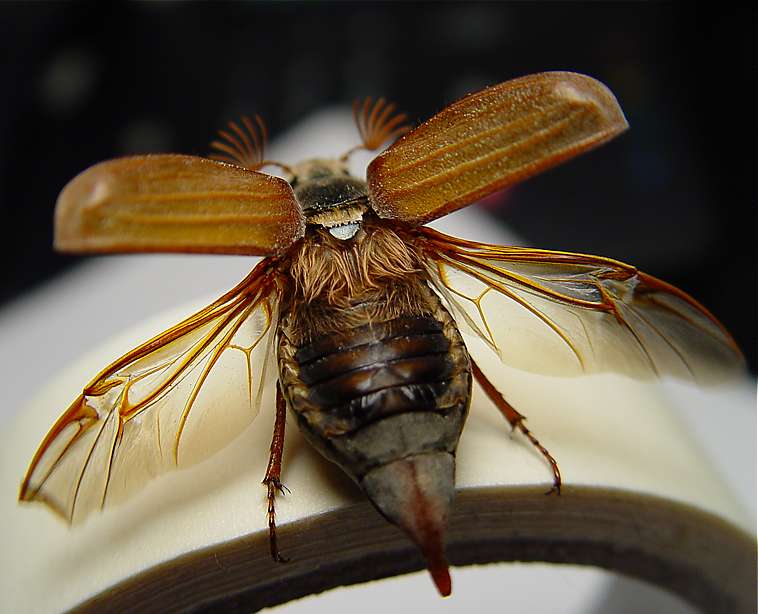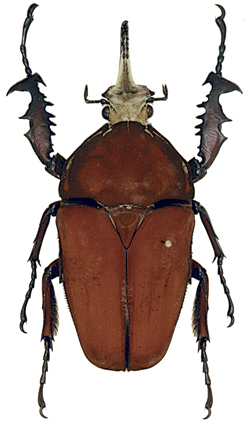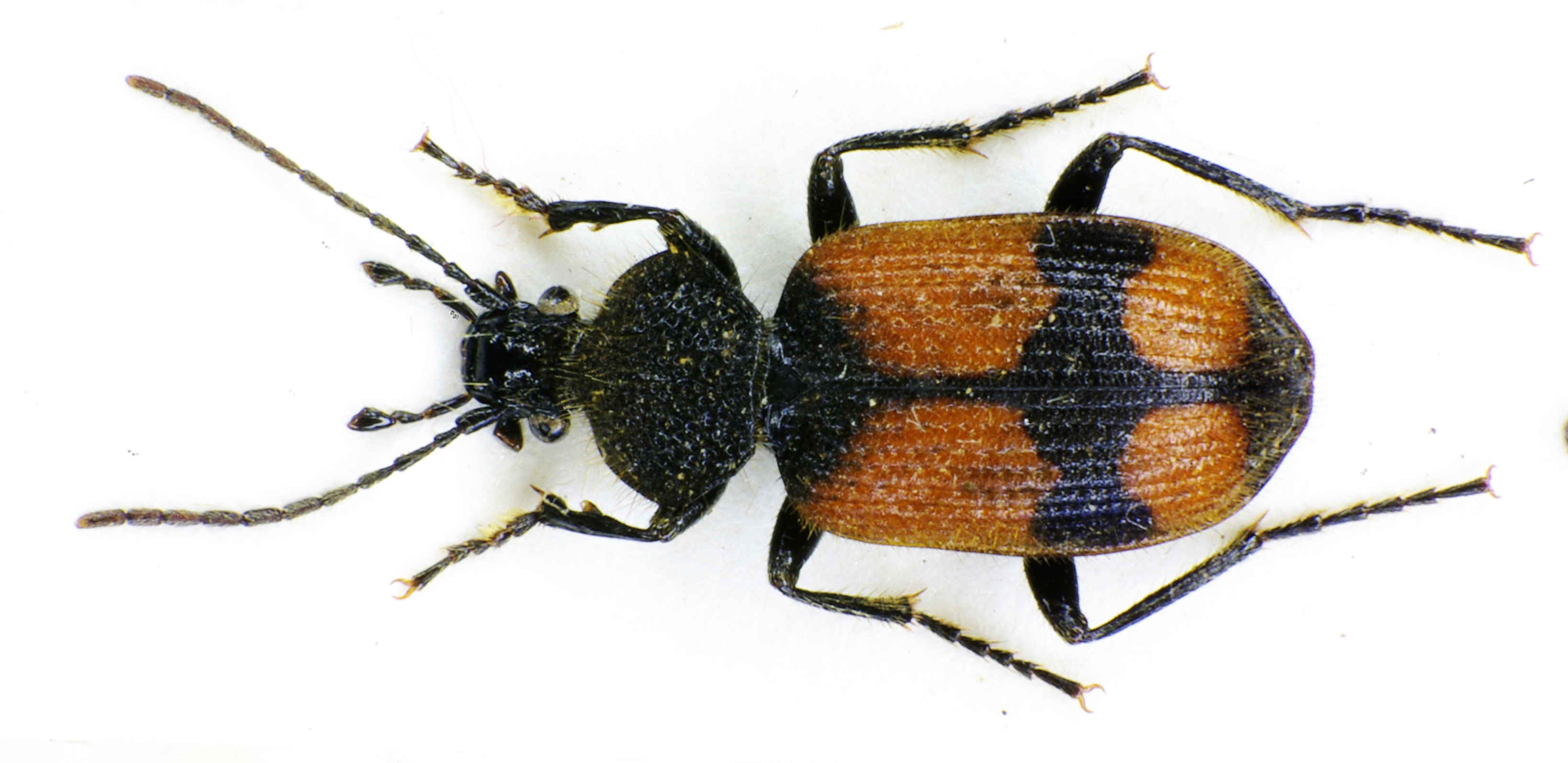|
Elytra
An elytron (; ; : elytra, ) is a modified, hardened forewing of beetles (Coleoptera), though a few of the true bugs (Hemiptera) such as the family Schizopteridae are extremely similar; in true bugs, the forewings are called hemelytra (sometimes alternatively spelled as "hemielytra"), and in most species only the basal half is thickened while the apex is membranous, but when they are entirely thickened the condition is referred to as "coleopteroid". An elytron is sometimes also referred to as a shard. Description The elytra primarily serve as protective wing-cases for the hindwings underneath, which are used for flying. To fly, a beetle typically opens the elytra and then extends the hindwings, flying while still holding the elytra open, though many beetles in the families Scarabaeidae and Buprestidae can fly with the elytra closed (e.g., most Cetoniinae; ). In a number of groups, the elytra are reduced to various degrees, (e.g., the beetle families Staphylinidae and Ripipho ... [...More Info...] [...Related Items...] OR: [Wikipedia] [Google] [Baidu] |
Beetle
Beetles are insects that form the Taxonomic rank, order Coleoptera (), in the superorder Holometabola. Their front pair of wings are hardened into wing-cases, elytra, distinguishing them from most other insects. The Coleoptera, with about 400,000 described species, is the largest of all orders, constituting almost 40% of described arthropods and 25% of all known animal species; new species are discovered frequently, with estimates suggesting that there are between 0.9 and 2.1 million total species. However, the number of beetle species is challenged by the number of species in Fly, dipterans (flies) and hymenopterans (wasps). Found in almost every habitat except the sea and the polar regions, they interact with their ecosystems in several ways: beetles often feed on plants and fungi, break down animal and plant debris, and eat other invertebrates. Some species are serious agricultural pests, such as the Colorado potato beetle, while others such as Coccinellidae (ladybirds or ... [...More Info...] [...Related Items...] OR: [Wikipedia] [Google] [Baidu] |
Hindwing
Insect wings are adult outgrowths of the insect exoskeleton that enable insects to fly. They are found on the second and third thoracic segments (the mesothorax and metathorax), and the two pairs are often referred to as the forewings and hindwings, respectively, though a few insects lack hindwings, even rudiments. The wings are strengthened by a number of longitudinal veins, which often have cross-connections that form closed "cells" in the membrane (extreme examples include the dragonflies and lacewings). The patterns resulting from the fusion and cross-connection of the wing veins are often diagnostic for different evolutionary lineages and can be used for identification to the family or even genus level in many orders of insects. Physically, some insects move their flight muscles directly, others indirectly. In insects with direct flight, the wing muscles directly attach to the wing base, so that a small downward movement of the wing base lifts the wing itself upward. Thos ... [...More Info...] [...Related Items...] OR: [Wikipedia] [Google] [Baidu] |
Forewing
Insect wings are adult outgrowths of the insect exoskeleton that enable insects to fly. They are found on the second and third thoracic segments (the mesothorax and metathorax), and the two pairs are often referred to as the forewings and hindwings, respectively, though a few insects lack hindwings, even rudiments. The wings are strengthened by a number of longitudinal veins, which often have cross-connections that form closed "cells" in the membrane (extreme examples include the dragonflies and lacewings). The patterns resulting from the fusion and cross-connection of the wing veins are often diagnostic for different evolutionary lineages and can be used for identification to the family or even genus level in many orders of insects. Physically, some insects move their flight muscles directly, others indirectly. In insects with direct flight, the wing muscles directly attach to the wing base, so that a small downward movement of the wing base lifts the wing itself upward. Those ... [...More Info...] [...Related Items...] OR: [Wikipedia] [Google] [Baidu] |
Cetoniinae
Flower chafers are a group of scarab beetles comprising the subfamily Cetoniinae. Many species are diurnal and visit flowers for pollen and nectar, or to browse on the petals. Some species also feed on fruit. The group is also called fruit and flower chafers, flower beetles and flower scarabs. There are around 4,000 species, many of them still undescribed. Ten tribes are presently recognized: Cetoniini, Cremastocheilini, Diplognathini, Goliathini, Gymnetini, Phaedimini, Schizorhinini, Stenotarsiini, Taenioderini, and Xiphoscelidini. The former tribes Trichiini and Valgini were elevated in rank to subfamily. The tribe Gymnetini is the biggest of the American tribes, and Goliathini contains the largest species, and is mainly found in the rainforest regions of Africa. Description Adult flower chafers are usually brightly coloured beetles, often metallic, and somewhat flattened in shape. The insertions of the antennae are visible from above, while the mandibles and lab ... [...More Info...] [...Related Items...] OR: [Wikipedia] [Google] [Baidu] |
Ground Beetle
Ground beetles are a large, cosmopolitan distribution, cosmopolitan family (biology), family of beetles, the Carabidae, with more than 40,000 species worldwide, around 2,000 of which are found in North America and 2,700 in Europe. As of 2015, it is one of the 10 most species-rich animal families. They belong to the Adephaga. Members of the family are primarily Carnivore, carnivorous, but some members are Herbivore, herbivorous or Omnivore, omnivorous. Description and ecology Although their body shapes and coloring vary somewhat, most are shiny black or metallic and have ridged wing covers (elytra). The elytra are fused in some species, particularly the large Carabinae, rendering the beetles unable to fly. The species ''Mormolyce phyllodes'' is known as violin beetle due to their peculiarly shaped elytra. All carabids except the quite primitive flanged bombardier beetles (Paussinae) have a groove on their arthropod leg, fore leg tibiae bearing a comb of hairs used for cleaning the ... [...More Info...] [...Related Items...] OR: [Wikipedia] [Google] [Baidu] |
Buprestidae
Buprestidae is a family (biology), family of beetles known as jewel beetles or metallic wood-boring beetles because of their glossy Iridescence, iridescent colors. Larvae of this family are known as flatheaded borers. The family is among the largest of the beetles, with some 15,500 species known in 775 genera. In addition, almost 100 fossil species have been described. The larger and more spectacularly colored jewel beetles are highly prized by insect collectors. The elytra of some Buprestidae species have been traditionally used in beetlewing jewellery and decoration in certain countries in Asia, like India, Thailand and Japan. Description and ecology Shape is generally cylindrical or elongate to ovoid, with lengths ranging from , although most species are under . ''Catoxantha'', ''Chrysaspis (beetle), Chrysaspis'', ''Euchroma'' and ''Megaloxantha'' contain the largest species. A variety of bright colors are known, often in complicated patterns. The iridescence common to these ... [...More Info...] [...Related Items...] OR: [Wikipedia] [Google] [Baidu] |
Hemiptera
Hemiptera (; ) is an order of insects, commonly called true bugs, comprising more than 80,000 species within groups such as the cicadas, aphids, planthoppers, leafhoppers, assassin bugs, bed bugs, and shield bugs. They range in size from to around , and share a common arrangement of piercing-sucking mouthparts. The name "true bugs" is sometimes limited to the suborder Heteroptera. Entomologists reserve the term ''bug'' for Hemiptera or Heteroptera,Gilbert Waldbauer. ''The Handy Bug Answer Book.'' Visible Ink, 1998p. 1. which does not include other arthropods or insects of other orders such as ants, bees, beetles, or butterflies. In some varieties of English, all terrestrial arthropods (including non-insect arachnids and myriapods) also fall under the colloquial understanding of ''bug''. Many insects with "bug" in their common name, especially in American English, belong to other orders; for example, the lovebug is a fly and the Maybug and ladybug are beetles. ... [...More Info...] [...Related Items...] OR: [Wikipedia] [Google] [Baidu] |
Ripiphoridae
Ripiphoridae (formerly spelled Rhipiphoridae) is a cosmopolitan family of some 450 described species of beetles sometimes called "wedge-shaped beetles". Ripiphoridae are unusual among beetle families in that many species are hypermetamorphic parasitoids, an attribute that they share with the Meloidae. Members of the family differ in their choice of hosts, but most attack various species of bees or wasps, while some others attack cockroaches or beetles. Many species of Ripiphoridae have abbreviated elytra, and flabellate or pectinate antennae. Biology The subfamily Ripiphorinae parasitise bees and wasps (Hymenoptera), while Ripidiinae parasitises cockroaches (Blattodea) and Pelecotominae parasitises larvae of wood-boring beetles (Coleoptera). Species that attack bees typically lay their eggs on flowers. There the eggs hatch almost immediately into small planidial larvae and lie in wait for a visiting host. The planidium mounts the bee and rides it back to the hive. Ther ... [...More Info...] [...Related Items...] OR: [Wikipedia] [Google] [Baidu] |
Staphylinidae
The rove beetles are a family (biology), family (Staphylinidae) of beetles, primarily distinguished by their short elytra (wing covers) that typically leave more than half of their abdominal segments exposed. With over 66,000 species in thousands of genera, the group is one of the largest families in the beetle order, and one of the largest families of organisms. It is an ancient group that first appeared during the Middle Jurassic based on definitive records of fossilized rove beetles, with the Late Triassic taxon ''Leehermania'' more likely belonging to Myxophaga. They are an ecologically and morphologically diverse group of beetles, and commonly encountered in terrestrial ecosystems. One well-known species is the devil's coach-horse beetle (''Ocypus olens''). For some other species, see List of rove beetle (Staphylinidae) species recorded in Britain, list of British rove beetles. Anatomy As might be expected for such a large family, considerable variation exists among the spe ... [...More Info...] [...Related Items...] OR: [Wikipedia] [Google] [Baidu] |
Maybug
The common cockchafer (''Melolontha melolontha''), also colloquially known as the Maybug, Maybeetle, or doodlebug, is a species of scarab beetle belonging to the genus ''Melolontha.'' It is native to Europe, and it is one of several closely-related and morphologically similar species of ''Melolontha'' called cockchafers, alongside ''Melolontha hippocastani'' (the forest cockchafer)''.'' The cockchafer develops via metamorphosis, in which the beetle undergoes stages of eggs, larvae, pupae and adults. The mating behaviour is controlled by pheromones. The males usually swarm during the mating season while the females stay put and feed on leaves. The leaves release green leaf volatiles when they are fed on by females, which the male can sense and thus locate the female for mating opportunity. The larvae use both the plant volatiles and CO2 to locate the plant root for food. This species is an important and nutritious food source for many species. The adults and larvae feed on plant ... [...More Info...] [...Related Items...] OR: [Wikipedia] [Google] [Baidu] |
Scarabaeidae
The family Scarabaeidae, as currently defined, consists of over 35,000 species of beetles worldwide; they are often called scarabs or scarab beetles. The classification of this family has undergone significant change. Several groups formerly treated as subfamilies have been elevated to family rank (e.g., Bolboceratidae, Geotrupidae, Glaresidae, Glaphyridae, Hybosoridae, Ochodaeidae, and Pleocomidae), and some reduced to lower ranks. The subfamilies listed in this article are in accordance with those in Catalog of Life (2023). Description Scarabs are stout-bodied beetles; most are brown or black in colour, but many, generally species that are diurnally active, have bright metallic colours, measuring between . The antenna (biology), antennae of most species superficially seem to be knobbed (capitate), but the several segments comprising the head of the antenna are, as a rule, lamellate: they extend laterally into plates called lamella (zoology), lamellae that they usually ... [...More Info...] [...Related Items...] OR: [Wikipedia] [Google] [Baidu] |
Ripiphorus Fasciatus-complex
''Ripiphorus'' is a genus of wedge-shaped beetles in the family Ripiphoridae. There are at least 30 described species in ''Ripiphorus''. Species These 34 species belong to the genus ''Ripiphorus'': * '' Ripiphorus aurantus'' Rivnay, 1929 * '' Ripiphorus blaisdelli'' Linsley and MacSwain, 1950 * '' Ripiphorus caboverdianus'' * '' Ripiphorus californicus'' (LeConte, 1880) * '' Ripiphorus calopterus'' Rivnay, 1929 * '' Ripiphorus columbianus'' Brown, 1930 * '' Ripiphorus dammersi'' Barber, 1939 * ''Ripiphorus diadasiae'' Linsley & MacSwain, 1950 * '' Ripiphorus epinomiae'' Linsley & MacSwain, 1950 * ''Ripiphorus eremicola'' Linsley and MacSwain, 1950 * '' Ripiphorus fasciatus'' (Say, 1823) * '' Ripiphorus flavicornis'' (Say, 1823) * '' Ripiphorus iridescens'' Rivnay, 1929 * '' Ripiphorus luteipennis'' LeConte, 1865 * '' Ripiphorus minimus'' (Pierce, 1904) * '' Ripiphorus mutchleri'' Rivnay, 1929 * '' Ripiphorus neomexicanus'' Rivnay, 1929 * '' Ripiphorus nevadicus'' (LeConte, 1880 ... [...More Info...] [...Related Items...] OR: [Wikipedia] [Google] [Baidu] |







